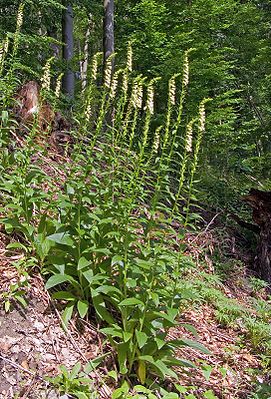Yellow thimble
| Yellow thimble | ||||||||||||
|---|---|---|---|---|---|---|---|---|---|---|---|---|

Yellow foxglove ( Digitalis lutea ) |
||||||||||||
| Systematics | ||||||||||||
|
||||||||||||
| Scientific name | ||||||||||||
| Digitalis lutea | ||||||||||||
| L. |
The yellow foxglove ( Digitalis lutea ) is a species of plant from the plantain family (Plantaginaceae).
description

The yellow foxglove is a biennial to perennial herbaceous plant and reaches heights of between 30 and 80 centimeters. The upright, unbranched stem is weakly runny and glabrous, the alternately arranged, narrow to ovate-lanceolate leaves are simple, finely ciliate on the edge, otherwise glabrous and irregularly serrate. A down-to-earth rosette at flowering time, as with other thimbles, is missing.
The inflorescence is a one-sided cluster of many, densely packed, sulfur-yellow, narrow-tube, patternless flowers that are 9 to 25 mm long and hairy on the inside. The flowers are smaller and narrower than those of the large-flowered foxglove , whose flowers are 28 to 40 mm long, ocher yellow and marked on the inside. The crown is made up of five fused petals . There are four stamens, the ovary is above and the fruit is a capsule . The leaves are missing the stipules .
The number of chromosomes is n = 56.
distribution
The plant is distributed from western Europe to southern Italy and north-west Africa. It grows preferentially on dry, calcareous, stony and warm soils in bright locations such as clearings or the edges of forest paths. It is Kennart the Association Atropo-Digitalietum luteae Oberd. 1957 (n.inv.) And is considered safe, but is "specially protected" in Germany by the Federal Species Protection Ordinance.
Systematics
One can distinguish the following subspecies:
- Digitalis lutea L. subsp. lutea : It occurs in Spain, France, Germany, Austria, Italy, Switzerland, the Netherlands, Belgium and the Czech Republic.
- Digitalis lutea subsp. atlantica : It occurs in Morocco.
- Digitalis lutea subsp. australis (Ten.) Arcang. : It occurs in Italy and Corsica.
- Digitalis lutea subsp. cedretorum Emb .: It occurs in Morocco.
- Digitalis lutea subsp. transiens (Maire) Emb. & Maire : It occurs in Morocco.
Toxicity
The plant is very poisonous. The main active ingredients are cardenolides with a relatively low total content:
- Lanatoside A 0.02 to 0.10%
- Acetyldigitoxin 0.01 to 0.08%
- Digitoxin 0.01 to 0.02%
The poisonous effect corresponds to that of Digitalis purpurea . The effectiveness of the heart also corresponds to that of Digitalis purpurea ; the effectiveness as a diuretic , however, should be stronger.
literature
- Erich Götz: Identify plants with the computer. Flora of Germany . CD-ROM. Eugen Ulmer, Stuttgart (Hohenheim) 2001, ISBN 3-8252-8168-X .
- Hans Simon (Ed.): The free-range ornamental shrubs. Manual and lexicon of garden perennials . Founded by Leo Jelitto, Wilhelm Schacht. 5th completely revised edition. tape 1 : A-H . Eugen Ulmer, Stuttgart (Hohenheim) 2002, ISBN 3-8001-3265-6 , pp. 294 .
- Lutz Roth, Max Daunderer, Karl Kormann: Poisonous plants plant poisons. 6th revised edition. Nikol-Verlag, Hamburg 2012, ISBN 978-3-86820-009-6 .
Individual evidence
- ↑ a b c d e f Karol Marhold, 2011: Scrophulariaceae : Data sheet Digitalis lutea In: Euro + Med Plantbase - the information resource for Euro-Mediterranean plant diversity.
Web links
- Digitalis lutea. In: FloraWeb.de.
- Yellow thimble . In: BiolFlor, the database of biological-ecological characteristics of the flora of Germany.
- Profile and distribution map for Bavaria . In: Botanical Information Hub of Bavaria .
- Digitalis lutea L. In: Info Flora , the national data and information center for Swiss flora . Retrieved March 12, 2016.
- Thomas Meyer: Thimble data sheet with identification key and photos at Flora-de: Flora von Deutschland (old name of the website: Flowers in Swabia )